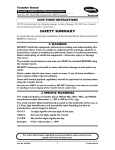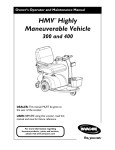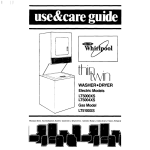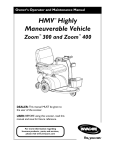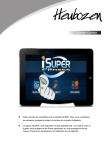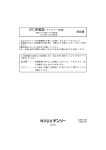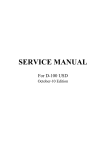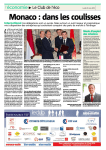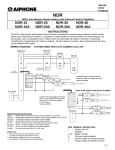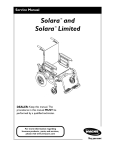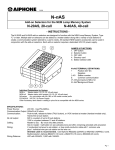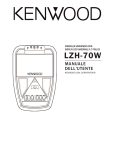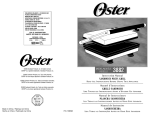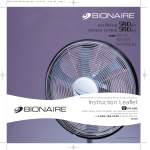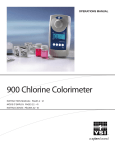Download Audioscope 3 Portable Screening Audiometer, User Manual
Transcript
WANM-3999-COL AudioScope3 3/11/97 1:23 PM Page FC-1 Portable Screening Audiometer Operating Instructions WANM-3999-COL AudioScope3 3/11/97 1:23 PM AudioScope® — U.S. Patent No. 4,567,881 AudioSpec® — Patent No. 4,380,998 Page FC-2 WANM-3999-COL AudioScope3 3/11/97 1:23 PM Page 1 Contents Warnings ................................................................................ 2 Standards Compliance.......................................................... 3 AudioScope 3 – Introduction ................................................ Hearing Loss.................................................................. Traditional Hearing Testing ............................................ 4 4 5 Screening Audiometry .......................................................... 7 Completing a Test.................................................................. 8 Guidelines for Selection of Screening Level ...................... 20 dB HL........................................................................ 25 dB HL........................................................................ 40 dB HL........................................................................ 12 12 12 12 General Protocol.................................................................... 13 Lamp and Battery Replacement .......................................... Cover Removal and Replacement ................................ Lamp Replacement ...................................................... Battery Replacement .................................................... 14 14 15 16 Recharging ............................................................................ Method 1: Using Charging Stand .................................. Method 2: Using Charging Transformer ........................ Method 3: Using MicroTymp Printer/Charger ................ 17 17 18 18 Wall Mounting Instructions .................................................. 19 Cleaning and Sterilization .................................................... Charging Transformer/Charging Stand.......................... AudioScope 3 ................................................................ AudioSpecs.................................................................... 20 20 20 20 AudioScope 3 Parts and Accessories ................................ Transformers (Charging) ................................................ 21 22 Service, Recalibration and Warranty .................................. Service .......................................................................... Recalibration.................................................................. Warranty ........................................................................ 23 23 23 24 Technical Specifications ...................................................... AudioScope 3 ................................................................ Charging Stand Specifications ...................................... Charging Transformers .................................................. Circuit Diagram for Charging Transformers .................. 25 25 27 28 28 1 WANM-3999-COL AudioScope3 3/11/97 1:23 PM Page 2 Warnings WARNING: Refer to Owner’s Manual. Use with Welch Allyn Charging Stand (#71123, #71126); Direct Plug-In Chargers (#71040, #71032, #71034, #71036) and/or MicroTymp Printer/Chargers (#71130, #71135, #71170, #71175) only. Use with approved accessories only. Lamp may be hot after use. Use caution during replacement. Not for use in the presence of flammable anesthetics. For Service in North America, instrument should be returned to an authorized Welch Allyn distributor or to Technical Service Department, Welch Allyn, Inc., 4341 State Street Road, Skaneateles Falls, NY 13153-0220 U.S.A. Telephone: 1-800-669-9771 (U.S.A. ONLY) OR 315-685-4560; 1-800-561-8797 (CANADA ONLY) OR 416-890-0004. AVERTISSEMENT : Se référer au Manuel de l’operateur. N’utiliser qu’avec le socle de charge Welch Allyn (n° 71123, 71126), les chargeurs directs enfichables (n° 71040, 71032, 71034, 71036) et/ou les imprimantes/ chargeurs MicroTymp (n° 71130, 71135, 71170, 71175). N’utiliser qu’avec les accessoires agréés. La lampe peut être brûlante après l’emploi. Observer des précautions en la remplaçant. Ne pas utiliser en présence d’anesthésiques inflammables. Clients situés en Amérique du Nord : réexpédier l’instrument à réparer à un distributeur agréé Welch Allyn ou au centre de service Welch Allyn suivant uniquement : Technical Service Department, Welch Allyn, Inc., 4341 State Street Road, Skaneateles Falls, NY 13153-0220 U.S.A. Téléphone: 800-669-9771 (É.U. UNIQUEMENT) ou 315-685-3445 ; 1-800-561-8797 (CANADA UNIQUEMENT) ou 416-890-0004. 2 WANM-3999-COL AudioScope3 3/11/97 1:23 PM Page 3 Warnings and Standards Compliance Standards Compliance The Model 23300 AudioScope 3 complies with the following standards to the extent that they apply to this instrument: Type BF equipment ANSI S3.6-1969 (R1973): Standard for Audiometers IEC 645-1979: Standard for Audiometers ETL listed: UL2601, CSA C22.2, No 601-1, IEC 601-1 71040 Only: UL Recognized, CSA Certified The CE mark on this device indicates it has been tested to and conforms with the provisions noted within the 93/42/EEC Medical Device Directive. 0297 0297 La marque CE figurant sur ce produit indique que les ésultats des tests auxquels il a été soumis sont conformes aux dispositions enregistrées dans la Directive 93/42/CEE concernant les instruments médicaux. Authorized European Representative Address: Adresse du représentant européen agréé : European Regulatory Manager Welch Allyn, Ltd., Kells Road, Navan, County Meath, Republic of Ireland Tel. 353 46 28122 Fax 353 46 28536 3 WANM-3999-COL AudioScope3 3/11/97 1:23 PM Page 4 AudioScope 3 – Introduction Thank you for purchasing the AudioScope 3. The operating and maintenance instructions found in this manual should be followed to ensure many years of accurate and reliable service. Please read these instructions thoroughly before using your new AudioScope 3. HEARING LOSS The Invisible Handicap Role of the Professional/Paraprofessional Over 20 million people in the United States (one out of every 15 individuals) suffer from hearing loss. Many other countries report similar statistics. Hearing problems can affect an individual’s social adjustment, speech and Ianguage development, academic progress, as well as the psychological well-being of that individual and his or her family. Fortunately, most hearing problems can be very successfully addressed through medical treatment and/or aural rehabilitation. The crucial element and first step is early detection, and it is here that professionals and paraprofessionals play a vital role. While audiologists and otolaryngologists are specially trained for testing and treating ear diseases, the primary care setting is ideally suited for first and early detection of the problem, since people frequently visit these groups: pediatricians, family practitioners, general practitioners, speech-language pathologists, nurse practitioners, physician assistants, public health personnel, school health nurses and volunteers. With a fast, simple, accurate method of hearing screening, early detection and appropriate referrals can be more efficiently and effectively accomplished. 4 WANM-3999-COL AudioScope3 3/11/97 1:23 PM Page 5 TRADITIONAL HEARING TESTING Tuning forks were one of the first methods used to determine the type of hearing loss. They may still be used by some to differentiate between conductive and sensorineural losses. However, they have in great part been replaced by the audiometer. AudioScope 3 – Introduction Traditional audiometers produce pure tones of varying frequency and intensity. Frequency is measured in Hertz (Hz) or cycles per second, and is perceived as pitch. Human hearing ranges from approximately 20 to 20,000 Hz. Intensity is measured in decibels (dB) and is perceived as loudness. Most often, hearing is measured by specialists in terms of threshold, or the faintest sound which an average listener can just hear in the quiet. Thresholds are measured at various frequencies, usually in the speech range (500 Hz to 4000 Hz) and just beyond (125 Hz to 8000 Hz). The magnitude or degree of loss is recorded on a form called an audiogram shown on Table 1 (p. 6). Measurements are made by air conduction, where the sound is introduced through a headphone into the ear. Measurements may also be made by bone conduction, where the sound is introduced through a vibrator which is placed on the mastoid bone behind the ear. By comparing these two measurements, the type of loss (conductive, sensorineural or mixed), can be determined. 5 WANM-3999-COL AudioScope3 3/11/97 1:23 PM Page 6 TABLE 1 Audiogram Showing Scale of Hearing Impairment* Frequency in Hz NORMAL Hearing Level (HL) in dB ANSI 1969 MILD MODERATE MODERATELY SEVERE SEVERE PROFOUND *Katz, J. “Handbook of Clinical Audiology,” Williams & Wilkins, 1985. 6 WANM-3999-COL AudioScope3 3/11/97 1:23 PM Page 7 Screening Audiometry The process of threshold and bone conduction testing can be timeconsuming and costly in terms of equipment and personnel. Such testing should be done in a soundproof room. This is not practical for many people for detection purposes. Therefore, many use a traditional audiometer but conduct a screening audiometric test. Generally, screening is conducted at 20 dB HL, 25 dB HL or 40 dB HL using the speech frequencies (500 Hz, 1000 Hz, 2000 Hz, 4000 Hz). Individuals who fail to respond at one or more frequencies in either ear are then referred. The Welch Allyn AudioScope 3 provides a unique means for accurate and efficient early detection of hearing loss. AudioScope 3 provides screening at the speech frequencies of 1000, 2000, 4000 and 500 Hz respectively, at a fixed decibel level. Choices of decibel levels include: 20 dB HL, 25 dB HL and 40 dB HL. Prior to the screening tones a practice tone or pretone (PT) is delivered at 1000 Hz and at 20 dB HL above the screening level. For example: When Screening at: 20 dB HL 25 dB HL 40 dB HL The 1000 Hz Pretone is set at: 40 dB HL 45 dB HL 60 dB HL The pretone allows the patient to hear a test tone at a level which is more audible than the screening level itself, thus allowing for practice. 7 Screening Audiometry This type of hearing screening is often done in school systems at several grade levels and by speech-language therapists in private practice. RARELY IS SCREENING PERFORMED IN OTHER NEEDED AREAS: in the physician’s office as part of a routine physical examination; in each and every school grade; hospital admitting; pediatric and ENT areas; nursing homes; high schools and colleges; industrial areas; public health clinics; and health maintenance organizations. WANM-3999-COL AudioScope3 3/11/97 1:23 PM Page 8 Completing a Test 1. Before starting, check that the lens is centered in the instrument. 2. Select an area that is relatively quiet and free from distracting conversation, fan noises, etc. (see p. 27 for allowable ambient noise specifications). 3. Select a small, medium or large AudioSpec ear speculum. Use the largest speculum that can be inserted comfortably into the ear canal, yet still allow visualization of the tympanic membrane. A snug fit assures an acoustic seal of the speculum in the ear and occludes ambient noise. Secure the AudioSpec to AudioScope 3 by twisting it clockwise onto the instrument. NOTE: Use only gray-tipped Welch Allyn AudioSpecs. Other types of specula will cause inaccurate results. 4. Turn AudioScope 3 “ON” by sliding the selection switch to the desired screening level (20 dB HL, 25 dB HL, or 40 dB HL; see p. 12 for guidelines). The white indicator band should completely fill the square next to desired sound level. The green “READY” indicator will become illuminated indicating that the instrument is ready for service. Should the yellow “LO BATT” indicator illuminate, see recharging instructions (p. 17 - p. 18). Lens Low Battery Indicator Tone Indicators dB Level and ON/OFF Switch Pretone Indicator “READY” Indicator Centering the lens Start Button Charging Jack Step 1 8 Step 4 WANM-3999-COL AudioScope3 3/11/97 1:24 PM Page 9 5. Instruct the patient that he/she will hear a loud tone (or beep) and then some fainter tones (or beeps). The patient is to respond every time a tone is heard. Responses can be verbal (“yes” or “beep”), gross motor (raising a hand, dropping a block in a bucket, waving a paper towel), or fine motor (raising a finger). Very young children may respond better via a verbal response, whereas seniors seem to perform better via a gross motor response. Children as young as four years of age may be tested with this instrument.1 Limitations in screening younger children are behavioral, not physiological, and are due to the interactive nature of the test. It is particularly important to reduce all sources of distracting auditory and visual stimuli. It is recommended that children be seated in such a position that they face a blank wall. Very young or uncooperative children should be referred to an audiologist since special procedures are required with these patients. Step 4 1. Bienvenue, G., Michael, P., Chaffinch, J., Zeigler, J. — “The AudioScope™, A Clinical Tool for Otoscopic and Audiometric Examination,” Ear and Hearing, Sept./Oct., 1985. 9 Completing a Test Examination of data by age groups indicates that the AudioScope screening procedure shows good validity in predicting categories of hearing acuity for subjects age 5 and older. For 3-year-old subjects the error rates were significantly higher. While error rates in the 4-year-old population were somewhat higher than the older subjects, the error rates were not so high as to make AudioScope screening unfeasible. Of those subjects in the 3-to4-year-old age group who showed errors on the screening procedure, all but two showed poor cooperation with both pure tone threshold audiometry and the screening technique. In view WANM-3999-COL AudioScope3 3/11/97 1:24 PM Page 10 of the general findings, it appears that the AudioScope can be used successfully with patients aged 4 years and older; however, care must be exercised to note the level of cooperation among the younger subjects. 2,3,4 6. Retract the patient’s pinna with the thumb and index finger. Gently pull it slightly up and back. With children, the pinna should be pulled back more than up. This facilitates insertion of the tip. 7. Grasp AudioScope 3 and gently insert speculum tip into the ear canal. NOTE: The handle may also be held in a horizontal position. Use little finger to stabilize instrument with respect to patient’s head. 8. Position the tip so that the tympanic membrane or a portion of it can be visualized. This visualization ensures free passage of sound. Step 6 Step 7 2. Gershel, J., Kugler, B., et. al., The Albert Einstein College of Medicine — “Accuracy of the Welch Allyn AudioScope™ and Traditional Hearing Screening for Children with Known Hearing Loss,” The Journal of Pediatrics, January, 1985. 3. Frank, J., Peterson, D. — “Accuracy of a 40dB HL AudioScope™ and Audiometer Screening for Adults,” Ear and Hearing, March, 1987. 4. Gershel, J., Giraudi-Perry. D., et. al., The Albert Einstein College of Medicine — “Comparison of Hearing Screened with the Welch Allyn AudioScope™ and a Traditional Audiometer,” Presented at ASHA, 1985. 10 WANM-3999-COL AudioScope3 3/11/97 1:24 PM Page 11 Do not attempt to perform procedures through the AudioScope 3 cavity. This may result in damage to the sound delivery system of AudioScope 3 or inaccurate readings. If the tympanic membrane is significantly occluded by wax, the ear should be cleaned prior to performing the hearing screen. Excessive wax may reduce the hearing sensitivity of a patient. 9. Maintain AudioScope 3 in the same position and depress the “START” button. The green light will then go out, and tone indicators which show the tone being presented will light sequentially. 10. Observe each tone indicator and the patient’s response. If, for any reason (i.e. patient movement, excessive ambient noise, etc.), the test is disrupted, it may be restarted at any time by depressing the “START” button again. It is important to keep AudioScope 3 stationary during the test to prevent generation of noise. 11. Repeat Steps 5 through 10 on the opposite ear. Rescreen if necessary (see General Protocol, page 13). 12. Turn the instrument “OFF” by sliding selection switch down. EXAMPLE ABOVE: All tones heard in left ear, none heard in right ear. Step 10 Step 13 11 Completing a Test 13. Complete the AudioScope Screening Results form and attach it to patient’s chart. WANM-3999-COL AudioScope3 3/11/97 1:24 PM Page 12 Guidelines for Selection of Screening Level 20 DB HL This is a typical screening level for the school-aged child. Although 25 dB HL is regarded as the upper limit for normal hearing2, one would expect the young child’s hearing acuity to be better than that of the adult. Therefore, American Speech Language Hearing Association (ASHA) guidelines for screening school children recommend use of 20 dB HL at 1000, 2000, and 4000 Hz with 500 Hz to be included if ambient noise levels permit.3 Ambient noise levels are a concern when screening at this level. It may be advisable to have room noise levels tested before using this level routinely (see p. 27 for maximum permissible noise levels). 25 DB HL This is a standard screening level used with adults, and with children in situations where ambient noise prohibits use of 20 dB HL. 40 DB HL This is a screening level which may be used to assess hearing impairment in those people aged 65 and above. Typically, failure at any frequency except 4000 Hz necessitates referral. An inability to hear 4000 Hz accompanied by inability to hear at least one other frequency also necessitates a referral. There is a debate in the audiological community as to the appropriateness of a 25 dB HL screen for seniors (those aged 65 and above). Many feel the question becomes one of identifying persons whose hearing impairment poses a handicap as opposed to the question of normal hearing. Many researchers4 propose 40 dB HL as the level of choice for this age group. AudioScope 3 gives you the flexibility of screening at 25 dB HL, 40 dB HL or both. 2. Katz, J. “Handbook of Clinical Audiology,” Williams & Wilkins, 1985 3. American Speech Language and Hearing Association, “Guidelines for Identification Audiometry,” ASHA, May 1985 4. Dalzell, L.E., PhD, Puccia, Swirat, D., M.A., Dept. of Audiology and Speech Pathology, Strong Memorial Hospital, “Hearing Loss, Hearing Handicap, and Hearing Aid Candidacy in Geriatrics,” presented at ASHA, 1983 Weinstein, B. E., St. John’s University, “Validity of a Screening Protocol for Identifying Elderly People with Hearing Problems,” ASHA, May 1986 12 WANM-3999-COL AudioScope3 3/11/97 1:24 PM Page 13 General Protocol Many professional and state guidelines suggest the following: If there is a failure at one or more frequencies in either ear, instruct the patient again and screen again. Failure at one or more frequencies on the second trial constitutes failure on the screen. (See specific instructions above for seniors.) Failure on a second screen indicates the need for further testing. The patient should be referred to an audiologist and/or otolaryngologist. IMPORTANT: A diagnosis or prescription for a hearing aid or drugs should not be made solely on the basis of AudioScope 3 results. This instrument is a screening device designed to identify people at risk for hearing loss and is to be used by the Professional to make appropriate referrals. General Protocol 13 WANM-3999-COL AudioScope3 3/11/97 1:24 PM Page 14 Lamp and Battery Replacement COVER REMOVAL AND REPLACEMENT If the lamp or battery is to be replaced, it is necessary to first remove the instrument cover: 1. Disconnect the charging transformer from AudioScope 3 and turn the instrument “OFF” before beginning. 2. Insert a coin into the slot of the lock mechanism at the end of the handle. 3. Turn the coin in either direction until the line under the word “OPEN” on the lock is aligned with the recessed line on the housing. Step 2 Step 3 4. Slide the cover back (away from the speculum end), until the arrows on the instrument case align. 5. Lift the cover. NOTE: Once the cover is removed, care should be taken not to touch any of the internal components except as described in this manual. Step 4 Step 5 14 WANM-3999-COL AudioScope3 3/11/97 1:24 PM Page 15 LAMP REPLACEMENT To remove old lamp: 1. Turn AudioScope 3 “OFF.” 2. LAMP MAY BE HOT—ALLOW TO COOL BEFORE PROCEEDING. 3. Follow instructions for cover removal (page 14). 4. Depress the blue lamp ejector lever (see Figure 1 below). The lamp will pop up. 5. Grasp lamp and remove. Fiber Optic Bundle Beveled end of lamp Lamp ejector lever Figure 1 To insert new lamp: 1. For best performance of Halogen lamps, remove any dirt or fingerprints from glass with a clean cloth moistened with 70% Isopropyl Alcohol before inserting lamp. Failure to follow cleaning procedures will result in permanent stains on the glass with reduction in light output. Average lamp life is 20 hours of on-time. 2. Rest lamp on lamp holder bracket with beveled end of lamp toward fiber optic bundle (see Figure 1 above). 3. Push lamp into lamp holder. NOTE: Replace with Welch Allyn No. 06200 lamp only. Other lamps may cause damage to the instrument or may cause inaccurate readings. 15 Lamp and Battery Replacement 4. Follow instructions for cover replacement (page 16). WANM-3999-COL AudioScope3 3/11/97 1:24 PM Page 16 BATTERY REPLACEMENT Turn AudioScope 3 “OFF”. Remove the cover and lift out the battery. Observe polarity markings when installing new battery. NOTE: Replace with Welch Allyn No. 72300 only. COVER REPLACEMENT The cover may be replaced in the opposite manner in which it was removed: 1. Place the cover over the instrument so that the arrows on the cover and the housing are aligned. 2. Press down gently on the cover and slide it up toward the speculum end of the instrument. 3. Return the lock mechanism to the locked position. 16 WANM-3999-COL AudioScope3 3/11/97 1:24 PM Page 17 The 3.5v nickel cadmium battery used in this instrument will provide approximately 50 minutes of continuous operation. When the battery is low, the yellow “LO BATT” indicator will illuminate and AudioScope 3 will automatically shut off, thereby preventing incorrect results due to inadequate battery voltage. Viewing illumination will remain on for a period of time after the low battery indicator becomes illuminated. The instrument may be recharged using any of the following three methods: METHOD 1: USING CHARGING STAND THIS CHARGING STAND CAN BE USED ON A DESK TOP OR MOUNTED TO A WALL: 1. Turn AudioScope 3 “OFF”. 2. Plug the output cord of the charging transformer into the jack of the charging stand. 3. Plug the charging transformer into a power receptacle of appropriate voltage, frequency and plug configuration. (No. 71040 Charging Transformer shown; see p. 22 for others.) 4. Place AudioScope 3 in charging stand. Handle will fit into well only one way. 5. By leaving AudioScope 3 in the charging stand, a fully charged instrument is always ready for use. Battery can be charged indefinitely without damage. A completely discharged battery can be fully charged overnight. Method 1 Handle will fit into well ONLY ONE WAY Handle receptacle for charging AudioScope 3 Four posts for storing Welch Allyn AudioSpecs Indicator light illuminates when instrument is charging properly Charging Transformer 17 Recharging Recharging WANM-3999-COL AudioScope3 3/11/97 1:24 PM Page 18 METHOD 2: USING CHARGING TRANSFORMER 1. Turn AudioScope 3 “OFF”. 2. Plug the charging transformer into a power receptacle of appropriate voltage, frequency and plug configuration (see p. 22). 3. Plug the output cord of the charging transformer into AudioScope 3 charging jack. 4. Place the instrument on its side. AudioScope 3 will not operate while recharging. A fully drained battery can be recharged overnight. The instrument can be left charging indefinitely without damage to instrument or battery. For longest battery life, use the instrument for at least 20 examinations before recharging, and vary the number of uses between recharges. Method 2 (71040 Charging Transformer shown) Step 2b Step 2c METHOD 3: USING MICROTYMP PRINTER/CHARGER The Printer/Charger for the Welch Allyn MicroTymp (Models 71130, 71135, 71170, 71175) may also be used to charge AudioScope 3. Follow instructions above for charging stand. NOTE: The bottom portion of AudioScope 3 handle will become slightly warm during recharging. 18 WANM-3999-COL AudioScope3 3/11/97 1:24 PM Page 19 Wall Mounting Instructions 1. Choose a location for the charging stand that is within five feet (1.5m) of an electrical outlet. Wall Mounting Instructions 2. Position mounting bracket vertically on wall and use as a template to pencil markings for drill holes. 3. Select correct mounting hardware: Sheet metal screws and plastic anchors for concrete block or plasterboard — .187" (4.75 mm) diameter drill. Sheet metal screws only for metal panel or wood walls .120" (3.05 mm) diameter drill. Note: If wall requires anchors, secure them to wall first. 4. Fasten mounting bracket to wall with screws. 5. Mount unit by aligning cutout in back of charging stand with the top of the bracket. Push charging stand down until seated securely on bracket. Charging Stand Bracket Mounting Screw 19 WANM-3999-COL AudioScope3 3/11/97 1:24 PM Page 20 Cleaning and Sterilization CHARGING TRANSFORMERS/CHARGING STAND None of the charging transformers nor charging stand should be sterilized. All may be cleaned by wiping with a dry cloth. Do NOT pour water or any cleaning solution into charging well or specula storage area. AUDIOSCOPE 3 May be cleaned by wiping with a dry cloth or a cloth that has been lightly dampened with 70% Isopropyl Alcohol. The cover and lens holder must be in place when the instrument is cleaned. Care should be taken to prevent seepage of liquid into the instrument. The lens assembly may be cleaned separately by sliding it out of the housing. NOTE: Do not attempt to clean or perform procedures through the AudioScope 3 cavity. This may result in inaccurate readings or damage to AudioScope 3 sound delivery system. AUDIOSPECS Will withstand cleaning or sterilization by any one of the following: Ethylene Oxide (130°F, 8 PSI, 4 hr. cycle) Steam Autoclave (270°F, 27 PSI, 6 minute cycle) Cidex Cidex 7 70% Isopropyl Alcohol Betadine (10% by volume) Zepharan Chloride (with or without anti-rust tablets) Wescodyne (10% by volume) Boil in water (30 minutes) 20 WANM-3999-COL AudioScope3 3/11/97 1:24 PM Page 21 AudioScope 3 Parts and Accessories The following replacement parts are available from your Welch Allyn Distributor: AudioSpecs No. 23303 Small No. 23305 Medium No. 23307 Large AudioScope 3 Parts and Accessories No. 23400 Complete Set (one each of small, medium and large) Battery No. 72300 3.5v Rechargeable Nickel Cadmium Carrying Case No. 05232 Soft Charging Stand No. 71123 Desk or wall mounting Lamp No. 06200 3.5v Halogen Results Forms No. 55230 Package of 100 21 WANM-3999-COL AudioScope3 3/11/97 1:24 PM Page 22 TRANSFORMERS (CHARGING) Any of the following Welch Allyn charging transformers may be used with this instrument: No. 71040 110-130v Input UL Recognized. CSA Certified No. 71032 220-240v Input Compliant with IEC 601-1 No. 71034 230-250v Input Compliant with IEC 601-1 No. 71036 230-250v Input SAA Approved All transformers operate at either 50 or 60 Hz. 22 WANM-3999-COL AudioScope3 3/11/97 1:24 PM Page 23 Service, Recalibration and Warranty SERVICE For customers in North America, please return instruments requiring service to a Welch Allyn Technical Service Department listed below or to an authorized Welch Allyn distributor. Technical Service Department Welch Allyn, Inc. 4341 State Street Road Skaneateles Falls, NY 13153-0220 U.S.A. Telephone: 800-669-9771 315-685-4560 Fax: 315-685-4653 Technical Service Department Welch Allyn Canada Ltd. 160 Matheson Blvd. East, Unit #2 Mississaugua, Ontario CANADA L4Z 1V4 Telephone: 800-561-8797 (in Canada only) or 905-890-0004 Fax: 905-890-0008 For customers outside of North America, return your instrument to a local, authorized Welch Allyn distributor or to your nearest Welch Allyn service center. RECALIBRATION In addition, a daily biological check may be performed. This is accomplished by a person with known normal hearing who listens to the tones for intensity and quality. 23 Service, Recalibration and Warranty The U.S. Occupational Safety and Health Administration (OSHA) recommends that audiometers be recalibrated annually. Arrangements may be made by returning the AudioScope 3 registration card or contacting Welch Allyn’s Technical Service Department or an authorized Welch Allyn Distributor. A moderate fee is charged for recalibration. WANM-3999-COL AudioScope3 3/11/97 1:24 PM Page 24 WARRANTY Welch Allyn, Inc. warrants the AudioScope 3 and the charging stand to be free of original defects in material and workmanship and to perform in accordance with manufacturer’s specifications for a period of one year from the date of purchase. If this instrument or any component thereof is found to be defective or at variance with the manufacturer’s specifications during the warranty period, Welch Allyn will repair or replace the instrument or component(s) at no cost to the purchaser. This warranty only applies to instruments purchased new from Welch Allyn or its authorized distributors or representatives. The purchaser must return the instrument directly to Welch Allyn or an authorized distributor or representative and bear the costs of shipping. This warranty does not cover breakage or failure due to tampering, misuse, neglect, accidents, modification or shipping, and is void if the instrument is not used in accordance with manufacturer’s recommendations or if repaired or serviced by other than Welch Allyn or a Welch Allyn authorized representative. No other express or implied warranty is given. Extend the AudioScope 3 warranty from one to three years. This warranty can be extended to three years provided the AudioScope 3 is returned to a Welch Allyn service location for recalibration annually. A moderate fee for recalibration will be charged. Purchase date determines warranty and annual recalibration requirements. Return of instrument registration card is required for proof of purchase, warranty validation and recalibration requirements. AudioScope 3 Rechargeable Battery Welch Allyn nickel-cadmium batteries are warranted by Welch Allyn for two years from date of manufacture (when used in Welch Allyn instruments only). Defective batteries will be replaced on a pro rata basis should failure occur prior to expiration date on battery. 24 WANM-3999-COL AudioScope3 3/11/97 1:25 PM Page 25 Technical Specifications AUDIOSCOPE 3 Size/Weight 8.5 in. (21.6 cm) Technical Specifications 1.42 in. (3.61 cm) 1.45 in. (3.68 cm) Weight 9 oz. (248 g) 25 WANM-3999-COL AudioScope3 3/11/97 1:25 PM Page 26 Operating Temperature Range: 59° to 95°F (15° to 35°C). All specifications apply over this temperature range. Frequencies: 500, 1000, 2000 and 4000 Hz ±3%. Distortion: Less than 3% total harmonic distortion (as measured at transducer input). Rise/Fall Times: 60 ±40 msec. as measured between the -1 and -20 dB points. Tone Duration: 1.5 ±0.2 sec. Pause Between Tones: Varied: between 1.0 and 2.0 seconds. Sound Level: Sound levels were established by threshold loudness balance method to TDH-39 receiver with MX41/AR cushion per ANSI S3.6 -1969 Ref. Thresholds. These levels were established in an independent study and are equivalent to standard audiometric headphones.5 ±3 dB @ 500, 1000 and 2000 Hz ±4 dB @ 4000 Hz. This corresponds to the following absolute sound pressure levels when the instrument is coupled to an occluded ear simulator per ANSI Std. No. S3.25-1979. Actual Sound Level (dB re 20 uPa) Freq. (Hz) 500 1000 2000 4000 For 20 dB HL 29.9 27.3 32.7 33.9 For 25 dB HL 34.9 32.3 37.7 38.9 For 40 dB HL 49.9 47.3 52.7 53.9 5. Bienvenue, G., Michael, P., Chaffinch, J. — “Reference Threshold Sound Pressure Levels for the Welch Allyn Audioscope”, Acoustical Society of America, 1984 26 WANM-3999-COL AudioScope3 3/11/97 1:25 PM Page 27 Maximum Permissible Ambient Noise for 20 dB HL Screen 55 dB A or 48 dB — 500 Hz octave filter 48 dB — 1000 Hz octave filter 48 dB — 2000 Hz octave filter 48 dB — 4000 Hz octave filter Maximum Permissible Ambient Noise for 25 dB HL Screen and 40 dB HL Screen 60 53 53 53 53 dB dB dB dB dB A or — 500 Hz octave filter — 1000 Hz octave filter — 2000 Hz octave filter — 4000 Hz octave filter Lamp: 3.5v Halogen, 20 hr. average life Battery: 3.5v nickel cadmium rechargeable — approximately 50 minutes of continuous operation between recharges. CHARGING STAND SPECIFICATIONS Dimensions: 4.5" (11.4 cm) 2.75" (6.99 cm) 4.25" (10.8 cm) Circuit Diagram: Technical Specifications 330 Pin Term Power Jack Model: 71123 75 2W Charging Well Sleeve Term Input: Models 71032, 71034, 71036 and 71040 Charging Transformers Output: Model 23300 AudioScope 3™ charging rate — 75 mA Leakage Current: See instructions for 71032, 71034, 71036 and 71040 Charging Transformers. Weight: 1 lb. 3 oz. (539 g). 27 WANM-3999-COL AudioScope3 3/11/97 1:25 PM Page 28 CHARGING TRANSFORMERS Model No. 71040 71032 71034 71036 Wt. A B C 4 oz. 190 gm 190 gm 175 gm 2.2" 70 mm 70 mm 63 mm 2.1" 40 mm 40 mm 43 mm 1.7" 40 mm 40 mm 43 mm CIRCUIT DIAGRAM FOR CHARGING TRANSFORMERS Refer to page 22 for Voltage, Hz, Input and Output for all models. Split Bobbin, Step-down Transformer (Core grounded for 71040 only) 28 WANM-3999-COL AudioScope3 3/11/97 1:25 PM Page 29 WANM-3999-COL AudioScope3 3/11/97 1:25 PM Page 30 Welch Allyn, Inc. 4341 State Street Road Skaneateles Falls, NY 13153-0220 (315) 685-4560 or (800) 535-6663 (in U.S.A. only) Fax (315) 685-3361 Part No. 230231-3 Rev. F Printed in the U.S.A.
































